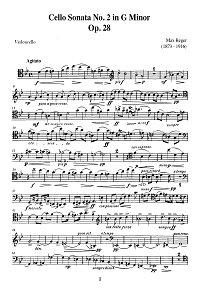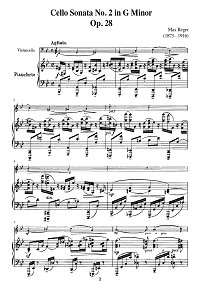Reger - Cello Sonata N2 g-moll op.28
|
Reger - Sonata N2 for cello and piano. You can download the sheet music Reger - Sonata N2 for cello and piano on this page.
Reger's Cello Sonata No 2 in G minor Op 28 was composed in 1898 and is dedicated to Hugo Becker (1863-1941), generally considered one of the greatest German cellists of the pre-Great War period. Reger was just emerging from several difficult years in which his lack of income, debilitating illness and heavy reliance on alcohol had undermined his constitution even as he was beginning to make his way professionally in the world and was winning esteem from composing contemporaries such as Busoni and Richard Strauss.
To download PDF, click the "Download PDF" button below the appropriate sheet music image.
To view the first page of Reger - Sonata N2 for cello and piano click the music sheet image.
|
| PDF format sheet music |
|
|
|
Cello part: 9 pages. 686 K
|
Piano part: 32 pages. 2482 K
|
 |
 |
|
|
| Download PDF (14.99
€) |
Download PDF (14.99
€) |
|
Despite the dedication to Becker and publication in Munich in 1899, the second Sonata was destined not to be performed until 1906. This time there are four movements, and the presence of a short Intermezzo rather than a full-blown slow movement lends the work something of a suite-like character. The Brahmsian influence, in many respects better assimilated than in Op 5, is patent from the thrusting outset of the Agitato first movement with its virile rising theme and surging accompaniment. This is a much more concise and concentrated sonata-form design than its counterpart in the previous sonata. A soft three-note figure in the piano serves to introduce the second subject, which expands from its initial espressivo character to forceful dotted-rhythm writing; mysterious, opalescent figuration introduces a brief codetta. All elements are pressed into service in the development, which throws up an oscillating sextuplet figure that persists into the beginning of the recapitulation. This again continues the process of development while passing the main subjects and their attendant satellites in review. The coda, brief and downbeat, builds upon the codetta of the exposition.
The ensuing scherzo, marked Prestissimo assai, and directed to be played sempre leggiero, is something like a very fast minuet, a witty essay 'im alten Stil'. The Andantino trio, however, is a warmly Romantic effusion with one of Reger's tenderest melodies. Something of the same spirit prevails at the start of the E major Intermezzo, where the music is almost redolent of the salon. But it develops into a quite strenuous Poco agitato whose march-like dotted rhythms and internal sextuplet rhythms seem reminiscent of the first movement. The opening idea returns, suitably expanded and embellished, sinking to a peaceful close.
The lilting, graceful rhythm of the last movement— marked Allegretto con grazia (Quasi allegro) and opening in a fulfilled G major—sets the mood for one of Reger's most inventive finales, which after traversing a good deal of ground harmonically and melodically, and occasionally disturbed by gusts of passion, ends swiftly and unexpectedly softly in a dying fall.
|
|